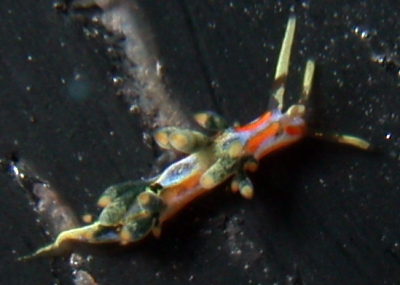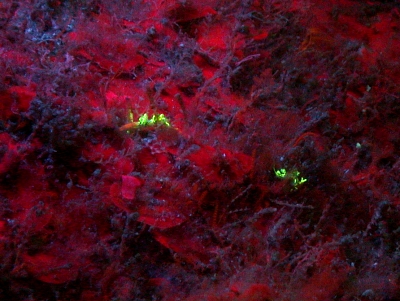
Cuthona millenae
Hermosillo & Valdes, 2007
Order: NUDIBRANCHIA
Superfamily: AEOLIDINA
Family: Tergipedidae
DISTRIBUTION
This species is known from various locations in the Mexican Pacific including the oceanic islands of Revillagigedo. Also from Costa Rica.
PHOTO
Locality: Islas Revillagigedo, 65 feet, Colima, Mexico, tropical eastern Pacific, 12 April 2007, Rocky subtidal. Length: 5 mm. Photographer: Ali Hermosillo.
The body is translucent with a pattern of opaque white regions and broad longitudinal bands of bright orange. On the head the background is opaque bluish white and there is an orange band on each side running from the base of the oral tentacles to the base of the rhinophores. Behind the rhinophores the orange band continues back on each side to the first ceratal cluster. A similar orange band on each side runs between the first and second ceratal clusters. There is another orange line on each side, below the cerata, running from the oral tentacles back behind the last ceratal row. The basal third of both the rhinophores and the oral tentacles is transparent and the upper two-thirds is an opaque milky yellow. At the junction of the clear and the yellow regions is a dark brownish band. The posterior part of the body, behind the last cerata to the tip of the tail, is an opaque milky yellow. The cerata are transparent with a yellow-orange tip and below that a central band with blotches of pale yellow orange. The deep green ceratal digestive gland shows through the ceratal wall.
The animal is small, approximately 5 mm in length, and has typical tergipedid features, such as the rounded anterior corners of the foot, and cerata arranged in rows. The rhinophores and oral tentacles are smooth and slightly taper to a rounded tip. The cerata increase in diameter to a maximum about two-thirds the way to the tip, and then narrow to a point. In the description the cerata are said to be arranged in 2 transverse rows, one in front of the pericardium and one behind. However in the photos there appears to be two rows in front of the pericardial space and one behind.
-
Hermosillo A. & Valdés, A. 2007. Five new species of Aeolid nudibranchs (Mollusca, Opisthobranchia) from the Tropical Eastern Pacific. American Malacological Bulletin, 22: 119-137, 13 text figures, 1 color pl.
Rudman, W.B., 2007 (August 6) Cuthona millenae Hermosillo & Valdes, 2007. [In] Sea Slug Forum. Australian Museum, Sydney. Available from http://www.seaslugforum.net/find/cuthmill
Related messages
Cuthona millenae from the tropical eastern Pacific
August 6, 2007
From: Alicia Hermosillo


Dear Bill,
As I mentioned in the reference to the publication where this and other aeolids are described, we had only two specimens of Cuthona millenae until my colleague and coral expert Pedro Medina and I started using flourescent filters [mesage #20286]and discovered that Cuthona millenae glows neon yellow and is apparently all over the place.
We now know it from various locations in the Mexican Pacific including the oceanic islands of Revillagigedo.
Locality: Islas Revillagigedo, 65 feet, Colima, Mexico, tropical eastern Pacific, 12 April 2007, Rocky subtidal. Length: 5 mm. Photographer: Ali Hermosillo.
I know it is a bit of a stretch, the close-up is not as tight because my fluo pictures still leave a lot to desire for, but I guess this one illustrates what can be seen.
Cheers
Ali
gueri25@hotmail.com
Hermosillo, A., 2007 (Aug 6) Cuthona millenae from the tropical eastern Pacific. [Message in] Sea Slug Forum. Australian Museum, Sydney. Available from http://www.seaslugforum.net/find/20387
Dear Ali,
I must say the normal colour of this animal is quite spectacular, even without the fluorescence. I often wonder why such small animals have such brilliant and complex colour patterns considering that they can't see and you would think that if you were warning predators, a simple bold design would be simpler.
Fluorescence is a whole new area of research. It has hit the public attention I guess because scientists transferred a jellyfish gene for fluoresence into a mouse. Their aim was not just to make glowing mice but to prove gene transfer between species was possible - just as you are using fluorescence to find cryptic nudibranchs. It does raise the question of why these nudibranchs fluoresce. I think the first discovery of flourescing animals was in some Australian parrots and its now thought they use it in communication - but that's a bit of guess I think. But it is now known to be quite widespread in marine animals including corals and other cnidarians, crustaceans, squid and who knows what else. Whatever its role is in the lives of those that have it, it is certainly a bonus for nudibranch hunters.
Best wishes,
Bill Rudman
